44 days, 11 hours, 59 minutes until the Once And Future President, Donald John Trump, is restored to the office that was Rightfully his the last four years.
Not that I’m counting, mind you.
What is it that feeds our battle, yet starves our victory?
January 6 Tapes?
Where are the tapes? Anyone, Anyone? Bueller? Johnson??
Paging Speaker Johnson…this is your conscience calling you out on broken promises.
Day of Infamy
One thing that many are counting is the 83rd anniversary of the Japanese sneak attack on Pearl Harbor.
When I was a kid it seemed like every account of World War II didn’t just call it an “attack” but rather a “sneak attack.”
It seems that we were as outraged by the “sneak” as we were by the “attack.” What made it a sneak attack was that it happened with no declaration of war by Japan. Here we are at peace with each other and WHAM!! our Pacific fleet is burning or already at the bottom of the harbor. (We can argue whether Roosevelt knew it was going to happen and let it happen, or whether we just got caught napping…either way the effect on the public was the same. I do think Roosevelt was on some level happy that we were in the war; he had up to that time wanted to help the allies a lot more than the American people did.)
If the telling in Tora! Tora! Tora! is to be believed (and I tend to believe it), the Japanese didn’t intend it to be a sneak attack. They intended to pass their declaration of war on to our government and then attack almost immediately, but slow decoding of the dispatch prevented that from happening; the attack happened before the message was delivered.
Whether that would have made a difference in the level of resolve we felt, is another question entirely. And so we have a straight line from this–the photograph taken from one of the Japanese aircraft just after the start of the attack, educating us on the folly of bottling up our fleet and parking our aircraft too close together:

To these two photographs, taken from two different aircraft, the Enola Gay and the Bockscar after they did a couple of “physics package” demos to complete Japan’s education in the folly of their foreign policy:

We had learned the lesson Japan had taught us on this day in 1941.
We are excellent teachers as well as studentsl we reinforced our lesson for the Japanese by repeating it. But we did a slightly different demo the second time–plutonium instead of U-235–in order not to be too repetitive.
The lesson stuck. Japan hasn’t been a problem on that scale, since.
And now, on to the Deep State, which needs a salutary lesson of its own.
News Flash
Today, it is still the case that Joe Biden didn’t Win.
I realize that to some readers, this might be a shock; surely at some point things must change and Biden will have actually won.
But the past cannot actually be changed.
It will always and forever be the case that Joe Biden didn’t win.
And if you, Leftist Lurker, want to dismiss it as dead white cis-male logic…well, you can call it what you want, but then please just go fuck off. No one here buys that bullshit–logic is logic and facts are facts regardless of skin color–and if you gave it a moment’s rational thought, you wouldn’t either. Of course your worthless education never included being able to actually reason–or detect problems with false reasoning–so I don’t imagine you’ll actually wake up as opposed to being woke.
As Ayn Rand would sometimes point out: Yes, you are free to evade reality. What you cannot do is evade the consequences of evading reality. Or to put it concretely: You can ignore the Mack truck bearing down on you as you play in the middle of the street, you won’t be able to ignore the consequences of ignoring the Mack truck.
And Ayn Rand also pointed out that existence (i.e., the sum total of everything that exists) precedes consciousness–our consciousnesses are a part of existence, not outside of it–therefore reality cannot be a “social construct” as so many of you fucked-up-in-the-head people seem to think.
So much for Leftist douchebag lurkers. For the rest of you, the regular readers and those lurkers who understand such things: I continue to carry the banner once also carried by Wheatie. His Fraudulency didn’t win.
Let’s Go, Brandon!!
His Fraudulency
Joe Biteme, properly styled His Fraudulency, continues to infest the White House, we haven’t heard much from the person who should have been declared the victor, and hopium is still being dispensed even as our military appears to have joined the political establishment in knuckling under to the fraud.
One can hope that all is not as it seems.
I’d love to feast on that crow.
(I’d like to add, I find it entirely plausible, even likely, that His Fraudulency is also His Figureheadedness. (Apparently that wasn’t a word; it got a red underline. Well it is now.) Where I differ with the hopium addicts is on the subject of who is really in charge. It ain’t anyone we like.)
Justice Must Be Done.
The prior election must be acknowledged as fraudulent, and steps must be taken to prosecute the fraudsters and restore integrity to the system.
Nothing else matters at this point. Talking about trying again in 2024 is hopeless otherwise. Which is not to say one must never talk about this, but rather that one must account for this in ones planning; if fixing the fraud is not part of the plan, you have no plan.
Lawyer Appeasement Section
OK now for the fine print.
This is the WQTH Daily Thread. You know the drill. There’s no Poltical correctness, but civility is a requirement. There are Important Guidelines, here, with an addendum on 20191110.
We have a new board – called The U Tree – where people can take each other to the woodshed without fear of censorship or moderation.
And remember Wheatie’s Rules:
1. No food fights
2. No running with scissors.
3. If you bring snacks, bring enough for everyone.
4. Zeroth rule of gun safety: Don’t let the government get your guns.
5. Rule one of gun safety: The gun is always loaded.
5a. If you actually want the gun to be loaded, like because you’re checking out a bump in the night, then it’s empty.
6. Rule two of gun safety: Never point the gun at anything you’re not willing to destroy.
7. Rule three: Keep your finger off the trigger until ready to fire.
8. Rule the fourth: Be sure of your target and what is behind it.
(Hmm a few extras seem to have crept in.)
Spot Prices.
Kitco Ask. Last week:
Gold $2,650.10
Silver $30.69
Platinum $954.00
Palladium $1002.00
Rhodium $4,850.00
FRNSI* 127.199-
Gold:Silver 86.351-
This week, markets closed as of 3PM MT.
Gold $2,634.20
Silver $31.11
Platinum $936.00
Palladium $982.00
Rhodium $4,850.00
FRNSI* 126.429+
Gold:Silver 84.674-
Gold down and silver up. This is good news for silver, which has been rising relative to gold, finally recovering somewhat from the disproportionate beating it took since the election.
*The SteveInCO Federal Reserve Note Suckage Index (FRNSI) is a measure of how much the dollar has inflated. It’s the ratio of the current price of gold, to the number of dollars an ounce of fine gold made up when the dollar was defined as 25.8 grains of 0.900 gold. That worked out to an ounce being $20.67+71/387 of a cent. (Note gold wasn’t worth this much back then, thus much gold was $20.67 71/387ths. It’s a subtle distinction. One ounce of gold wasn’t worth $20.67 back then, it was $20.67.) Once this ratio is computed, 1 is subtracted from it so that the number is zero when the dollar is at its proper value, indicating zero suckage.
The Final Experiment
…starts in one week.
Eric Dubay of the two hundred proofs contradicting himself, at one turn insisting he’d love to go to Antarctica to see for himself, and when offered the opportunity, refusing to concede that he had ever said so.
Disgraceful behavior from the Flerfers. Predicted by the globers. Will Duffy initially didn’t believe they’d turn on their own like this (as the globers said they would), but finally just had to come out and call them on it.
In related news, one of the globers had to back out for medical reasons. The Final Experiment is actually getting a special campsite at almost 80 degrees South–one where no terrain will occlude the Sun– and now they were below the threshold (nine) that the company doing the logistics actually needed for the special camp. So Duffy had to find someone to take the open slot.
And who stepped up? A full-blown, Hollywood-grade documentary producer named Jonathan Mariande. He will make a documentary of the trip.
AND MARIANDE IS A FLAT EARTHER.
This will make it even harder for the Flerfers to tap dance around what happens.
It must be great to be a charlatan and make money off of suckers…until the truth outs. Then suddenly you see your life turning to garbage. Sorry, no sympathy from me.
It Came From Deep Space
If there’s one thing almost all of the moons of the outer solar system…and all of the TNOs…share in common it’s that they’re largely made out of water ice.
Honestly if anyone tries to sell you on the idea that space aliens are going to come here to steal our water, just laugh in their faces.
They don’t even have to come almost all the way to Earth just to filch water from our TNOs, they certainly have similar things in their own systems. Water is the most common heteronuclear molecule (i.e. composed of more than one kind of atom) in space.
Which makes sense. Half of all of the “stuff” in the universe that is not hydrogen and is not helium, is oxygen. And after being blasted out into space in a planetary nebula or supernova, the first thing an oxygen atom is likely to find (once thing settle down enough to let it hang onto eight electrons) is a hydrogen atom, or even a hydrogen molecule, because there are seventy grams of hydrogen for every gram of oxygen…which means 1100 hydrogen atoms for every oxygen atom. There’s plenty of helium around too but that’s fluff from a chemical standpoint. So the first thing that lone oxygen atom is going to find isn’t another oxygen atom to form O2, but hydrogen, to form OH then another to form H2O. Badda-bing! Water.
This notion of most solid things being made largely out of water ice is foreign to us, because Earth is almost purely rocks (which, OBTW, generally contain plenty of oxygen) and (deep, deep down) iron-nickel. If Earth actually had its share of water, it’d be Water World, with no rocks within hundreds of miles of the surface. It would look like Europa would look, if Europa melted. (Europa probably has more water in that subsurface ocean than Earth has in total, in spite of being much smaller than Earth.)
Where did our water go? It got blown away by heat. When the Earth first formed it was a molten mass; the water certainly vaporized, and at those temperatures Earth’s gravity would not hold it. Then the stream of energy and particles from the Sun would simply have whisked it away. (In fact we still lose a tiny bit of water vapor this way from our atmosphere even at our current temperatures.)
The next natural question is…OK, it’s not necessarily the next natural question, but this is my post and I’m going to go there anyway: So what would happen if one of those mostly-ice objects somehow ended up getting close to the Sun? The same thing.
You don’t have to take my word for it. This actually happens, a lot. Have a look.

Yes. Comets are basically bodies from the outer solar system that somehow end up getting into an orbit that brings them closer to the Sun. They spend billions of years “out there” just minding their own business, when some other body–perhaps another comet, or a planet, maybe even a rogue planet (one that has escaped its parent star) wanders through and perturbs its orbit, and it drops towards the Sun.
It’s now in a highly elliptical orbit. Depending on where it came from the comet may be regarded as a “short period” comet if it came from the Kuiper Belt or the scattered disk–places I talked about last time–or it may be a “long period” comet if it came from further out.
Further out?
It’s the existence of so many long-period comets that has convinced astronomers that the Kuiper Belt and scattered disk are not the outermost parts of the solar system. Instead it’s thought that these long-term comets originate from a very sparse and gigantic zone called the “Oort Cloud” (pronounced like “port” without the “p”) named after Jan Oort who first proposed it. (Note the third Dutch astronomer who has had a major role in this series on the solar system.)

These orbit anywhere from 2000 to 50,000 AU, though estimates of that upper end vary; I’ve seen numbers as high as 200,000 AU for the upper bound, and so will you by the time you finish this.
For reference, the nearest (other) star to our solar system is at a distance of 268,551 AU (or 1.3 parsecs or 4.25 light years). [Which should tell you how ridiculously far apart stars are in comparison to the sizes of solar systems…much less the sizes of the stars themselves.]
We have never, ever detected an object that is in the Oort Cloud. Too far away, and too small. We only know about it from backtracking comets. And because of these “ambassadors” from the Oort cloud, we know a fair amount about the objects in the Oort Cloud, as a class. We can’t send a probe to them, not in this lifetime, but they sometimes come most of the way to us.
History
Comets have been known, and feared, since ancient times.
The night time sky is mostly changeless. Oh, the stars shift a bit westward from one night to the next, but after a full year, you’re back where you started from; that in fact is a direct consequence of our yearly orbit about the Sun.
We see planets and the moon moving around, but they are at least somewhat predictable (even by very ancient peoples); they tend to stick being near a band about the sky called the ecliptic. In fact the Sun stays on the ecliptic though that’s a bit harder to see since you can’t see the Sun and the stars at the same time. The point being the planets were predictable and though some people tried to do “woo” with planetary positions, people in general weren’t scared of them.
There were also shooting stars, but even though those are quite unpredictable, they’re fairly frequent.
But a comet? Comets are big, spectacular, hang around for months, and completely unpredictable. There could be a big one next year. Or not. Thus they tended to be regarded as bad omens.
And then came Sir Isaac Newton and Edmond Halley.
Isaac Newton, I’ve discussed enough. He was able to show that a force that could be described mathematically (and thus, precisely) was responsible for the orbits of the planets. At that point they became viewed as essentially a clockwork. His work was published in Philosophiae Naturalis Principia Mathematica in 1687, thanks in part to Edmond Halley’s funding and encouragement.
Halley had already made observations of a comet that showed up in September of 1682. He used that data to show that that comet, too, was in an orbit fully consistent with Newton’s gravitation, but rather than a nearly circular orbit, the comet was in a highly elliptical orbit–one with an eccentricity of 0.96658, where 0 is circular and 1.0 is a parabola or line segment. And the orbit has a period of 76 years. Its semi-major axis (i.e., halfway along its length) is 17.737 AU, its nearest approach to the Sun is 0.59279 AU (inside the orbit of Venus), while its furthest distance is 35.14 AU, beyond the orbit of Neptune (which wasn’t known yet!).
Halley published this in 1705, along with data on other comets.
But here was the key implication: There’s be another comet in 1682+76=1758, but it would actually be the comet of 1682, returning.
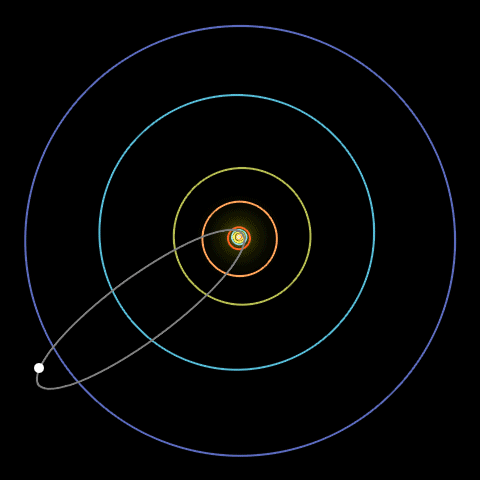
And sure enough, sixteen years after his death in 1742 at the age of 82, a comet showed up…and it was in the right place, following the right path. That comet is now known as “Halley’s Comet.” (“Halley,” by the way, rhymes with “Valley,” at least that’s the way most people with that name pronounce it today. We’re not 100% sure that’s they way they pronounced it back then, it might have rhymed with “Holly.” Or it may actually have been Hail-ee, as it is commonly pronounced by non-astronomers.)
[Note, by the way, that the animation shows Halley’s comet orbiting clockwise. Yes, it’s retrograde just like irregular satellites are. But if you think about it other than minimum distance this looks an awful lot like an irregular satellite.]
Halley had predicted a comet. And thus, comets became something explicable. Sure, we couldn’t predict when the next long term comet would show up, but the short term ones we could predict like clockwork, and either kind, once visible, would follow predictions as to their path across the sky.
Well, mostly. The difficulty is, that an orbital calculation assumes the object isn’t under any kind of thrust. But when a comet is near the Sun, it’s constantly outgassing as it warms up…and those jets of gas act like random rocket burns. But now we knew what comets are, and that took all of the supernatural “woo” out of them.
And the terror. Well, mostly; but 1910 is a special case of panic caused by scientific illiteracy.
Once comets became an irregular but nevertheless normal phenomenon, astronomers started looking for them. Any unexpected, diffuse blob in a telescope could turn out to be a comet in the early stages of warming up and outgassing. Charles Messier (1730-1817), in fact, made it a hobby to look for comets, and made a catalog of objects–ones that were nebulous in appearance but were not comets–that had fooled him, so that he could check against it in the future to weed out false alarms. This is now known as the Messier catalog, and although it’s by no means comprehensive (it has 110 objects in it), it’s famous. Many objects in the sky are known by their Messier numbers, for example M 31 in Andromeda (the “Andromeda Galaxy”) or M 1, the Crab Nebula. Amateur astronomers even hold “Messier Marathons” during the one month of the year when they are all visible sometime, somewhere, between dusk and dawn, trying to get all of them. (On my one attempt, I got all but 15 or so of them.) Messier did discover 13 comets, and co-discovered a fourteenth.
Now that we knew what we were looking for, we have found Halley’s comet in records from 240 BCE, in Chinese chronicles. And then in 164 BCE in a couple of Babylonian tablets…actually fragments of tablets. And again in 87 BCE in more Babylonian tablets. (And it may be depicted on Armenian coins.)
The appearance of 12 BCE was recorded in China. It likely passed pretty close to Earth then. It so happened that in Rome, Marcus Vipsanius Agrippa died at that time, so the Romans took it as an omen of his death. It is also sometimes cited as a possible Star of Bethlehem (though it seems a bit early for that to me).
There is a possible record of the appearance of 66 CE, the Chinese recorded its appearance in 141. Then we apparently missed one, because the next one is 374, then 451 (heralding the defeat of Attila the Hun). Past that point, we can find every single appearance in the records. The most famous of these was in 1066, meaning someone was going to have a very bad year. Well, it was either going to be Harold (if he lost the English throne) or William (if Harold stopped him from seizing the British throne). It’s convenient that no matter what happens, the comet will turn out to have been an omen! And of course we know that Harold lost out to William the Conqueror, bringing the French language with him. (And English spelling has sucked ever since.)
The comet is depicted on the Bayeaux Tapestry, telling the history of the Battle of Hastings:
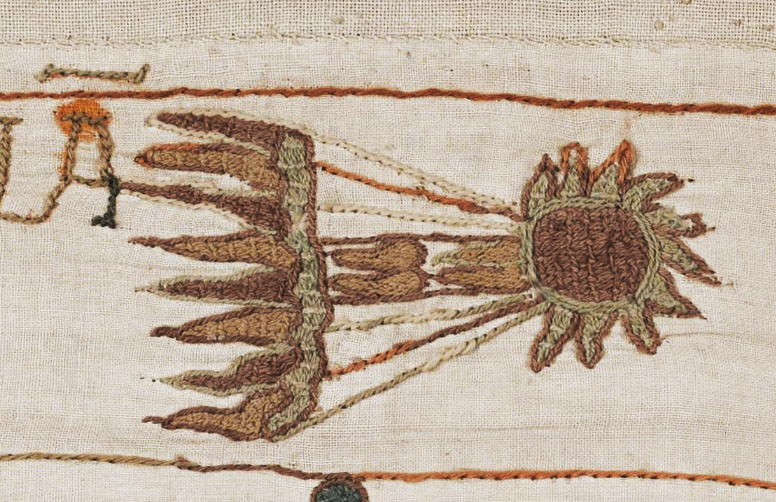
Speaking of the Star of Bethlehem, in 1305 Giotto di Bondone produced a work, the Adoration of the Magi, which depicts the star of Bethlehem as a comet. How did he know what a comet looked like? He had seen Halley’s comet in 1301, and that time, it was visually spectacular.

As it turns out, one of the probes that visited Halley’s Comet in 1986, was named Giotto after this artist.
In 1835 the comet appeared, and Mark Twain was born two weeks after its closest approach to the Sun. It was during this apparition that German astronomer Friedrich Wilhelm Bessel (who also developed the Bessel functions–very eclectic stuff) suggested that jets of evaporating material might supply enough force to alter a comet’s orbit.
In 1909 Twain stated that he “came in with Halley’s comet in 1835. It is coming again next year, and I expect to go out with it. It will be the greatest disappointment of my life if I don’t go out with Halley’s comet. The Almighty has said, no doubt: ‘Now here are these two unaccountable freaks; they came in together, they must go out together.'” And sure enough, Twain died on 21 April 1910, the day after the comet’s closest approach to the Sun.
In 1910, we had the benefit of spectroscopy and photography. We could tell from the light, what the comet was made of. One thing found was the toxic gas cyanogen. Earth was expected to pass through the tail of the comet, so a panic ensued with people afraid all life on Earth would be snuffed out, and thus buying gas masks and “anti-comet pills” that were useless (a better record than COVID “vaccines”). The fact of the matter is that a comet’s tail is so diffuse it had no effect.
Here’s the comet in 1910, taken from the Yerkes Observatory, at the time home to the largest telescope in existence. (It still is the largest refracting telescope in existence.)
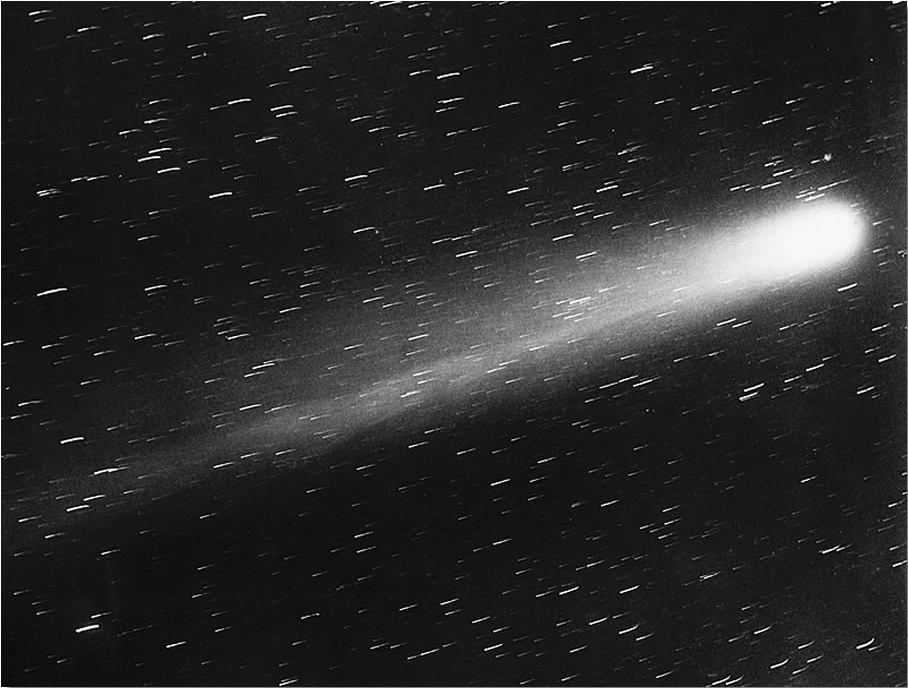
Based on my grandfather’s recollection, it was a spectacular appearance. Or perhaps he was remembering a different comet; the Great Daylight Comet of [January] 1910, which could be seen even in daytime!
Speaking of comet tails…now would be a good time to discuss the structure comets. Or it may be a bad time. But this is my post, so we will.
The Anatomy of a Comet
At the very heart of a comet is the nucleus. This is the icy object that–when it’s out in the Kuiper Belt, Scattered Disk, or Oort Cloud, just minds its own business, it’s a bunch of ice, dust, and rocks, mostly water ice but also carbon dioxide, carbon monoxide, methane and ammonia. They range from 100 meters across to possibly as much as 30 km across. Often they are called “dirty snowballs.” Comets that have passed by the Sun multiple times in the past will tend to have more rock and dust at their surfaces–any ice there boiled off during a previous visit. They are very dark in color, reflecting as little as four percent of the light that reaches them.
Surrounding the nucleus is the coma, it’s basically the sum total of all of the stuff that is outgassing from the comet, and any dust that is being carried along with the outgassing. It can be thousands or even millions of kilometers across.
Here you can see the nucleus of the Hartley comet, complete with very active jets of material:
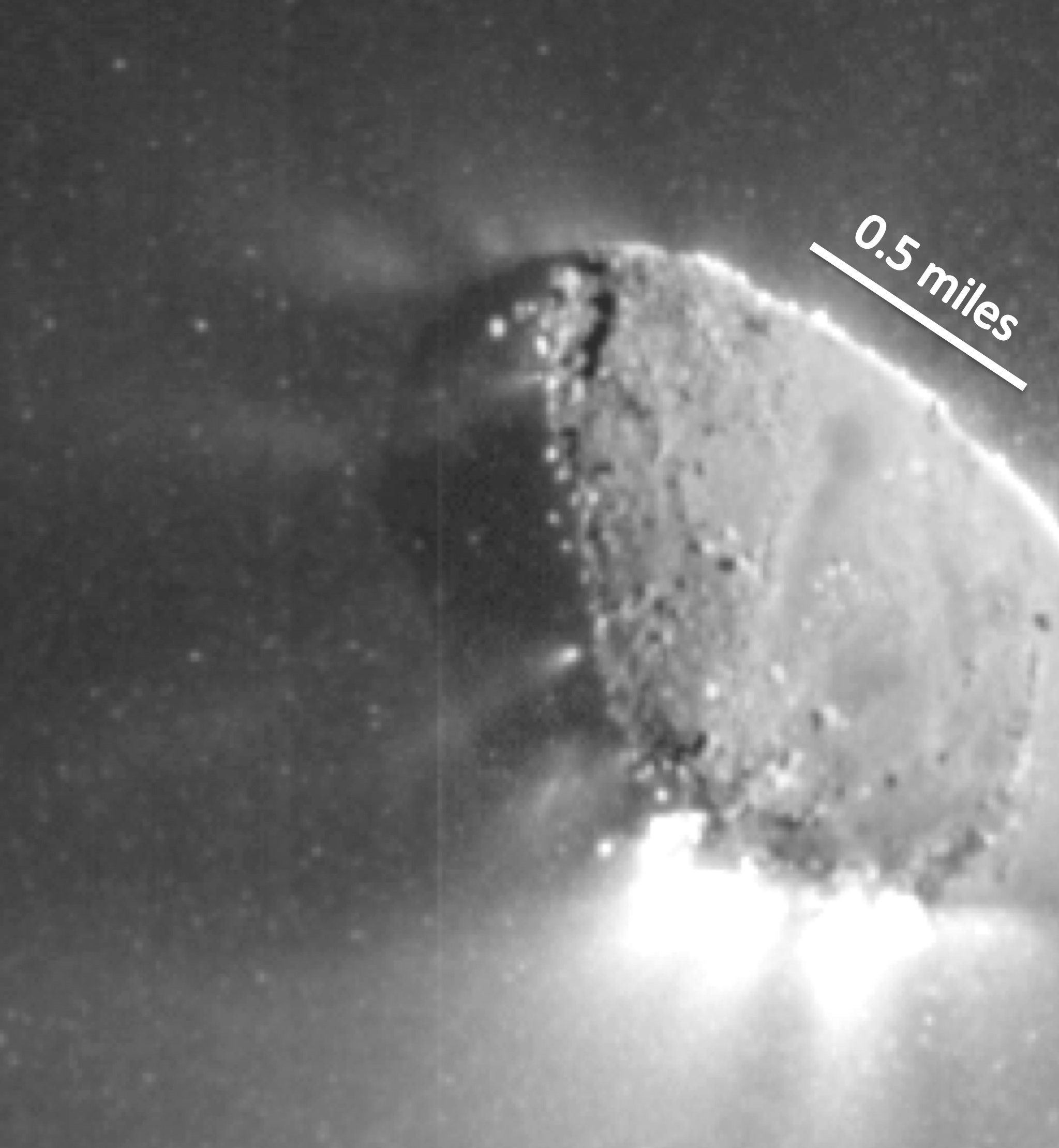
The tails form…yes, I said “tails”…when the coma material interacts with either solar radiation or the solar wind. One tail will be curved and will consist of the dust and other (relatively) heavy particles. The other is the gas tail, pure gases, and that one will always point directly away from the Sun; these are lighter things that are pushed away instantly by the pressure of the solar radiation.
The gas tail glows because the gases become ionized…in other words it actually emits light. The dust tail, on the other hand shines by reflected sunlight (like planets do).
Tails have been known to be 3.8 AU long… that’s over half a billion kilometers.
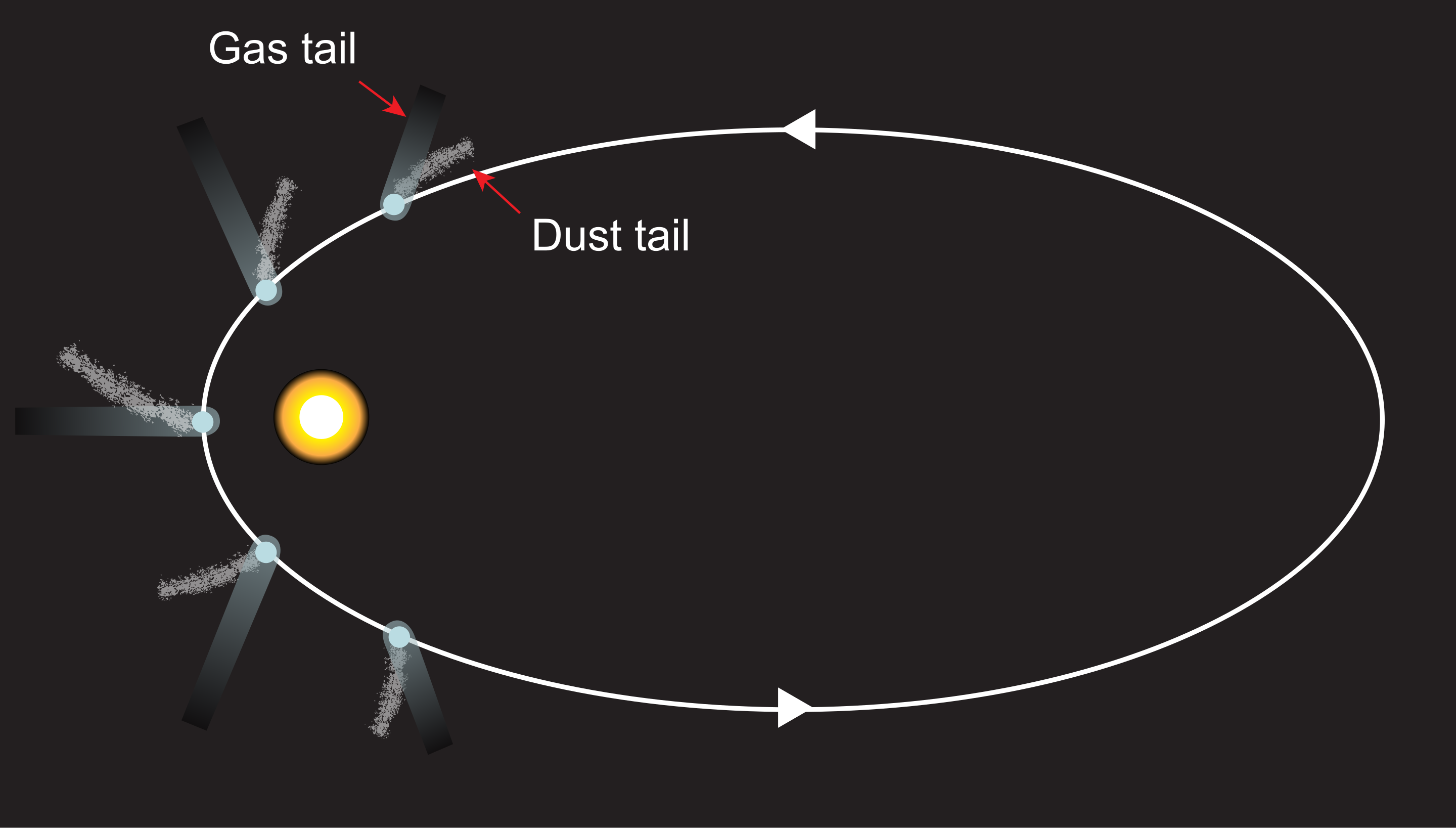
The one statistic that I clearly remember reading a lot when I was younger was how rarefied a comet’s tail is. For all of the visual appearance, it’s a near perfect vacuum (just not as close as space normally is). But I haven’t been able to nail it down on the internet. Suffice it to say it’s very, very sparse.
Here’s an animation

So, comets are huge, when they’re active.
Comets that pass by the Sun multiple times will eventually run out of ice to have vaporize. They may then resemble asteroids, or the object may have no cohesion and become swarms of small objects–dust particles, mostly. Those can eventually cause meteor showers on Earth when the Earth eventually passes through them. There are a number of these over the course of a year, generally named for the constellation the meteors seem to radiate from as seen from the ground. Typically there are good and bad years for meteor showers, depending on whether Earth is cutting through the center of the swarm or not.
Categories of Comet
As alluded to above, comets are roughly divided between short period and long period. Short period, or to many astronomers, just plain “periodic” comets are generally those whose period is less than 200 years. Usually, but by no means always, they orbit in at a low inclination, close to the ecliptic, the plane of the planets’ orbits, and in the same direction as the planets. This is an important clue. Short term comets are generally former long term comets that passed too close to one of the planets and had their orbits perturbed. Many will be sub-grouped into “families” based on the outermost extent of their orbits; that’s thought to be an indication as to which planet did the deed. In the case of Halley’s comet, since its orbit extends just a bit past Neptune’s orbit, it’s believed that Neptune perturbed its orbit. The largest of these families is (no surprise) the Jupiter family. There are also comets that orbit within the asteroid belt…they have the right composition, but very little outgassing happens that far away from the Sun.
Long Period comets can have periods of thousands or even millions of years. Those latter are our evidence for the existence of the Oort cloud. Comets C/1999 F1 and C/2017 T2 (PANSTARRS) have a semi major axis of 35,000 AU and a period of six million years. If you missed them when they first showed up, you’re basically out of luck as far as seeing them the next time. You’ll have to wait for them to reach their maximum distance from the Sun…over a light year (!), then come back.
But some comets are literally never expected to come back; those are the single-apparition comets.
If the Kuiper Belt and Oort cloud seem a bit bewildering here is another diagram for comparison…actually it’s three diagrams, one each of the asteroid belt, Kuiper Belt and Oort cloud. These are not drawn to any kind of scale; for instance in the last diagram the planet orbits and Kuiper belt are much too big; and as always the planets themselves and even the Sun are drawn much too large (they should be much less than one pixel in size).
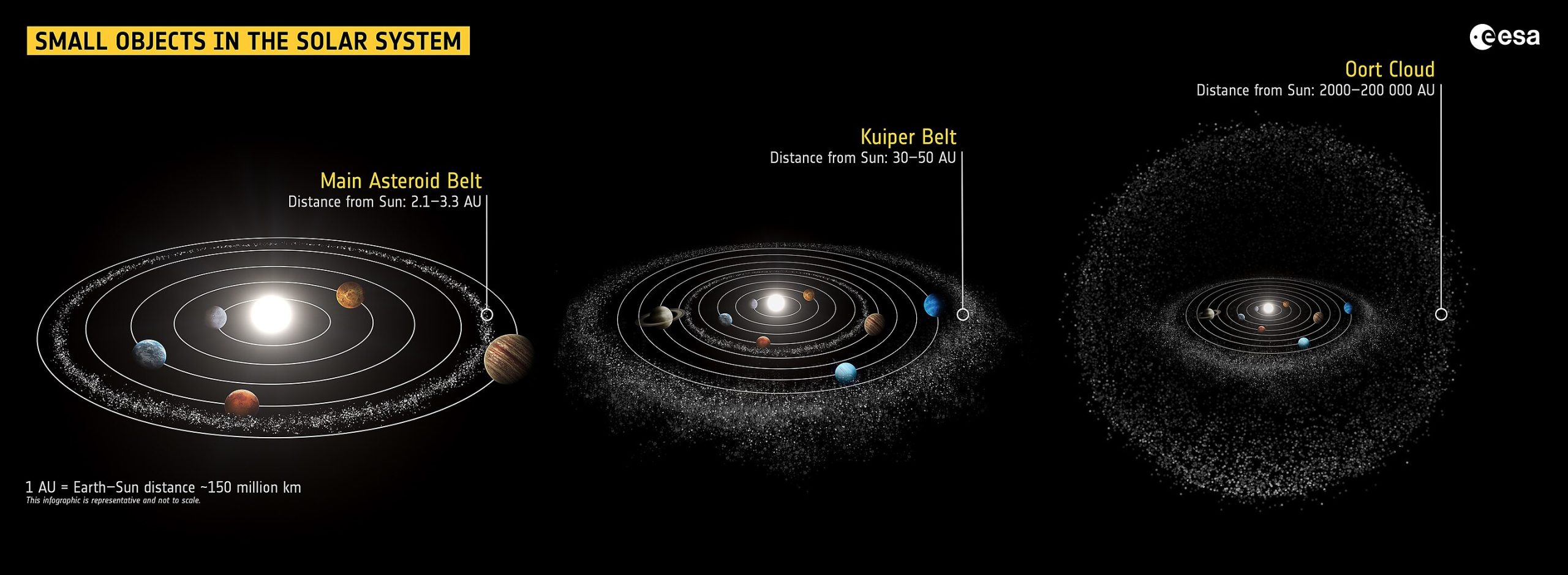
Other Famous Comets
There are over 3,500 known comets. Most never get bright enough to be seen with the naked eye, but some become famous for one reason or another. Halley’s comet, of course, is the undisputed celebrity.
9P/Tempel was discovered in 1867 by William Tempel, and has a 5.6 year period. We lost track of it in 1898 and assumed it had disintegrated, but it was rediscovered in 1967. It turned out that its orbit had been perturbed, and that is how we lost it; it wasn’t where we expected it to be. We have sent probes to this one.
Kohoutek (C 1973 C1) in 1973 was a fizzle. Early estimates of how bright it would get made it seem as if it would be one of the brightest comets of the century, but then…big nothing! And it faded from sight by the end of January 1974. It’s hard to predict how bright a new comet will be, because we rarely have a good feel for how much ice it has, how deeply it’s buried, and so on. On a comet’s second trip, though, we will have a past history to go off of.

Kohoutek is a classic long term comet. Its measured eccentricity was between 0.9999 and 1.0. A 1.0 orbit is an escape orbit (barely), so we don’t expect to see Kohoutek again any time soon. Current estimates are that it is in a 75,000 year orbit. It passed only 0.14 AU from the Sun, meaning it went inside the orbit of Mercury.
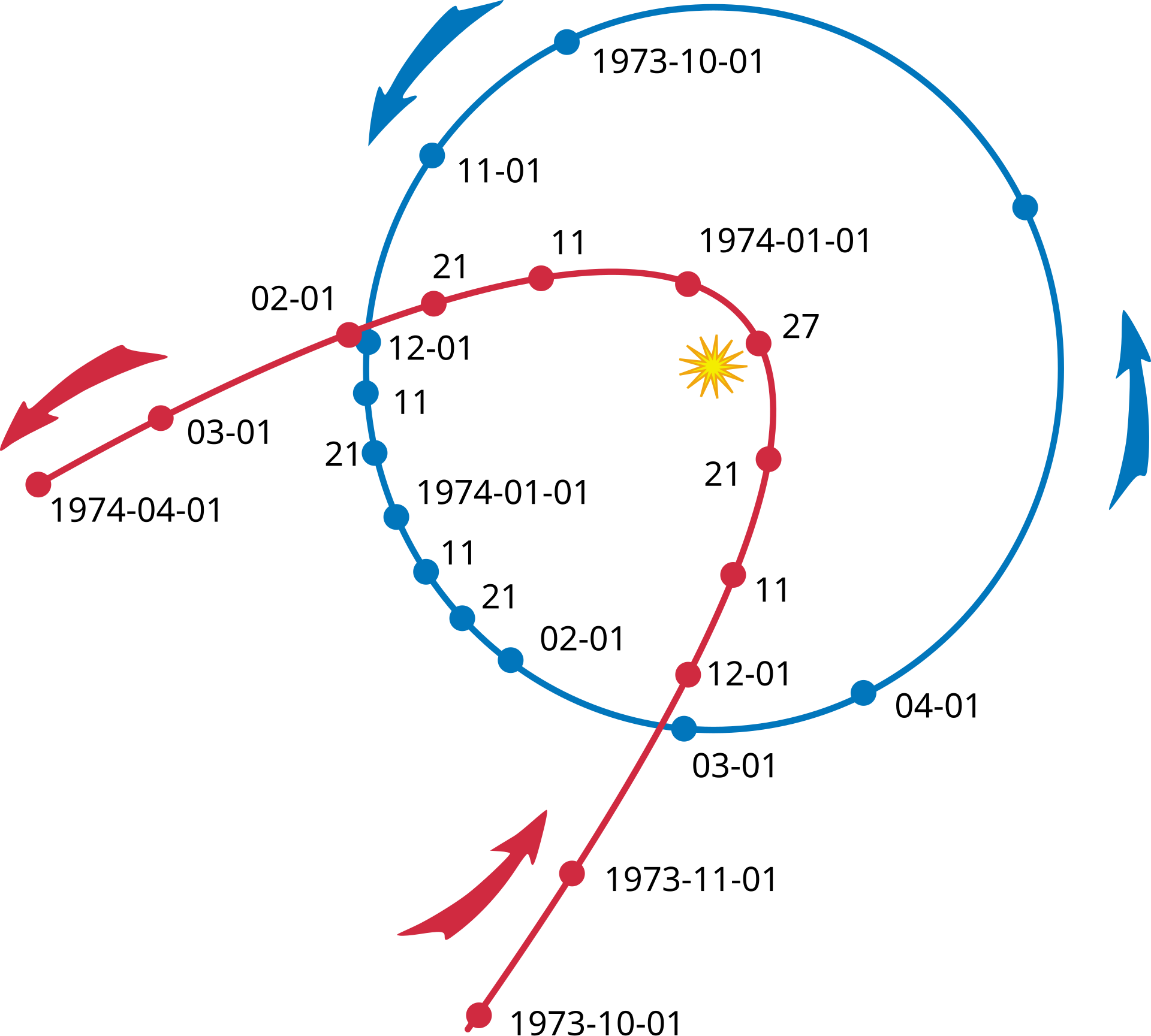
Hyakutake in 1996 passed very near Earth (about 15 million km) over the north pole and was readily visible late at night (rather than being buried in twilight. I went outside the city away from the lights to see it as it traversed the Big Dipper and it noticeably moved in just ten or fifteen minutes. This was an unusual opportunity, comets are usually brightest (as seen from Earth) near the sun so it’s unusual to see a bright comet in a truly dark sky.
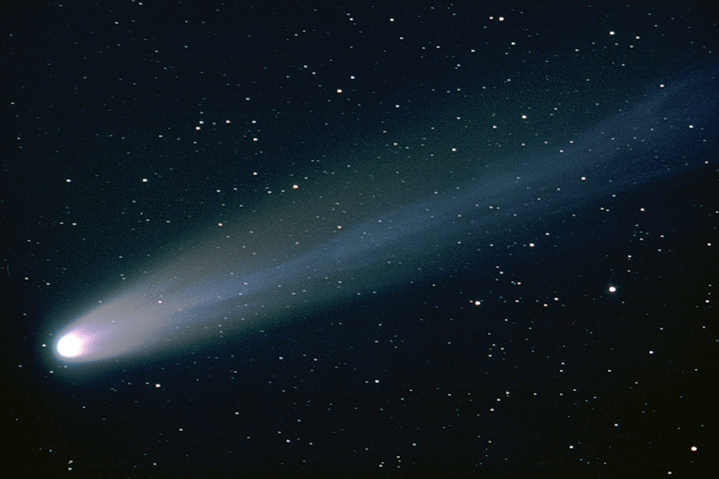
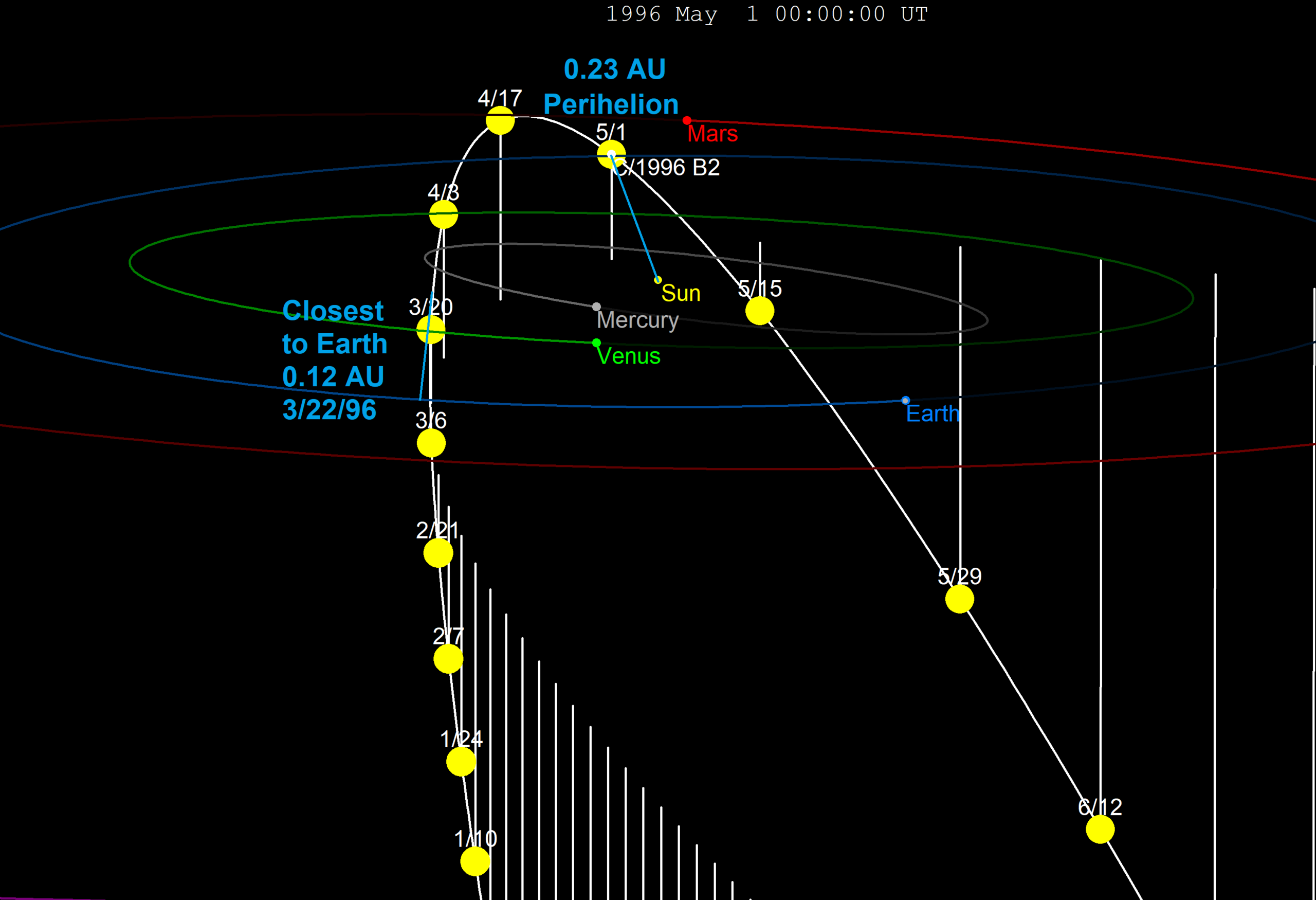
The comet came in from “below” the plane of the ecliptic (bottom center), crossed the plane of the ecliptic then over our north pole on March 22, zipped through perihelion (closest approach to the Sun, then dropped below the plane of the ecliptic and exited, lower right. Unlike with Kohoutek, this probably isn’t Hyakutake’s first visit; it’s in a 17,000 year orbit with an excentricity of “only” 0.99989.
The Ulysses spacecraft–one studying the Sun–passed through Hyakutake’s tail.
Hyakutake, however, was overshadowed by Hale Bopp, just a few months later in 1997. Hale Bopp is actually the comet I used at the beginning of this post. I unfortunately never got a good look at it. At most I saw some fuzz at twilight, and then it would set. I could never get far enough away from the city fast enough at sunset to get a good look at it. Apparently it came into its own later, after I had given up on it. So for me Hyakutake was “the” comet.
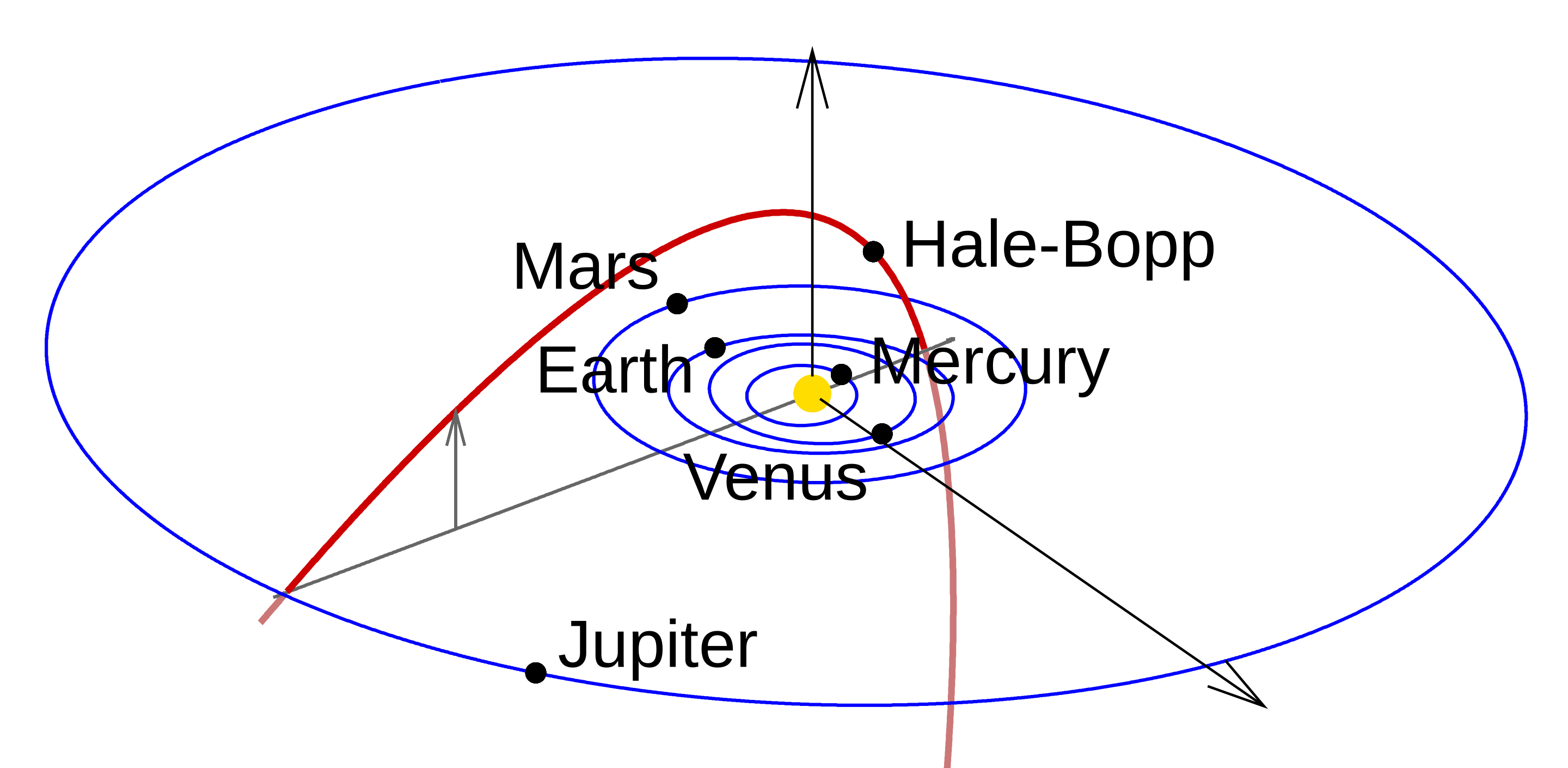
So I really missed the boat on this one, but I’ll get another crack at it in abut 2400 years. This is by no means a short-period comet but it has a significantly shorter period than Kohoutek and Hyakutake, and its orbit has a semi-major axis of a mere 177 AU.
Shoemaker-Levy 9 This one, no one would ever have cared about (other than Carolyn and Eugene Shoemaker, and David Levy, the co-discoverers of it the comet. They discovered it in 1993…and it had already broken into 21 pieces, probably sometime in 1992 when it approached Jupiter (yes…tidal forces!). But then when they plotted its orbit, the astronomers realized two things: the pieces were actually in orbit about Jupiter, not the Sun, and also that they were going to make direct hits on Jupiter in July of 1994! (Hard to believe that was thirty years ago!)

By the time it hit, Shoemaker-Levy 9 was in twenty one pieces and every one of them hit Jupiter.
The comet fragments were up to 2 km in diameter…meaning before it broke up it was actually pretty big.
How would Jupiter hold up getting pummeled like this?
The bad news is the pieces hit just into the dark side of Jupiter. That means we couldn’t see the actual moments of impact from Earth. Hubble got retasked to look; The Ulysses probe got retasked…and the Galileo orbiter was 1.6 AUs out, but it could actually see the impact site. NOTHING was more important than this.
One of the most famous pictures in astronomy is of the black holes the impacts left in Jupiter’s atmosphere.
The largest piece, G, hit with 6,000,000 megatons of of energy. It took months for the atmosphere to recover from the hits. Some of the blemishes were the size of Earth.

Perhaps we will leave such smoking holes in the Deep State, shortly.
This was particularly poignant for Eugene Shoemaker. He almost got to go to the Moon on Apollo 17 as the geologist, but for medical reasons never got to do it. He was however the head of the geology program for many years..
But one of his big “things” was warning people about the dangers of possible future asteroid and comet impacts. He spent time studying Meteor Crater in Arizona, he discovered that the Ries in Germany was an old impact crater (that wasn’t hard. It turned out that St. George’s church in Nördlingen was built out of rock that clearly had been altered by the force of an asteroid impact (it’s very distinctive; no volcano or other Earth-bound force can produce it). After that all he had to do was find the right quarry in order to bag his…er…quarry.
Geologists and astronomers had pooh-poohed his warnings, but Shoemaker-Levy 9 vindicated him completely. Now we’re quite aware of the very real danger of being hit by one of these objects. We’ve had two significant…but still very small…pieces hit since 1900, both in Russia: 1908 Tunguska and 2013 Chelyabinsk.
Exploration
When recounting the history of Halley’s comet, I stopped at 1910, not 1986. That’s because we were able to send probes…yes more than one…to the comet because we had plenty of advance notice. In fact we sent five probes. The European Space Agency sent Giotto, the Soviet Union sent Vega 1 and Vega 2, Japan sent Sakigake and Suisei.
NASA didn’t do a damned thing. However they did send a mission, ICE, to another comet the year before, and therefore the first mission to study a comet was an American probe. Another six missions have been sent to other comets since, including one lander and one deliberate impact:
Deep Space (launched 1998) used an ion drive for manuevering. It had two targets, it missed its first target and managed to reach its second target.
Stardust (launched 1999) actually captured dust from Wild, one of its target comets, and launched a capsule that returned that dust to Earth. So we got to put bits of comet into test tubes in a lab here on Earth. The other comet was…well let me hold that until later.
CONTOUR (launched 2002) was intended to study two comets but failed. Plan B was to head to yet a third comet, but the spacecraft couldn’t be contacted. Can’t win ’em all.
All missions up to that time were flybys, but we actually set up an orbiter, Rosetta, launched by the European Space Agency in 2004. It orbited 67P Churymov-Gerasimenko in 2014 and attempted to land. In the meantime, it took pictures, like this one.
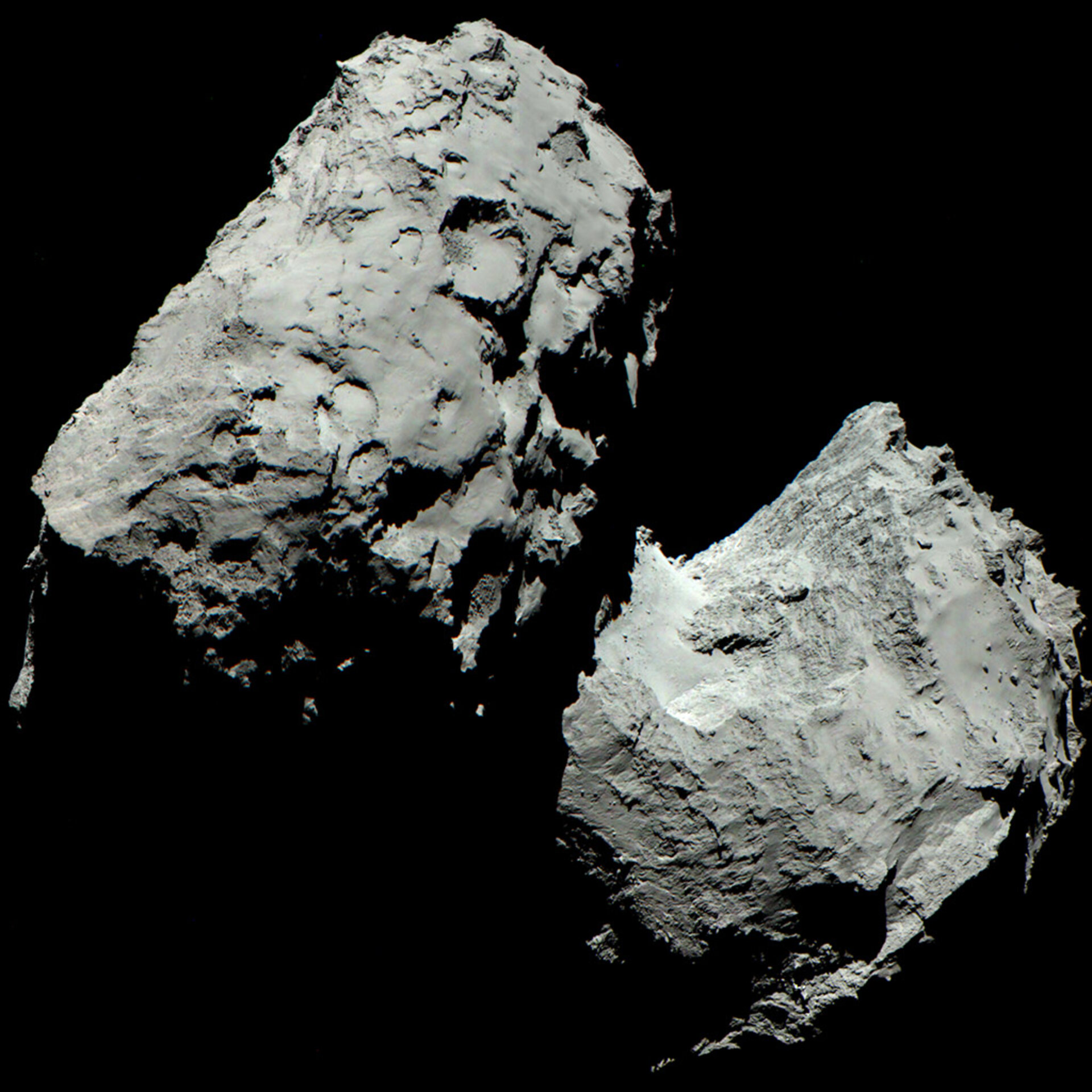
Rosetta had company; ESA had launched two probes on the same day and Philae‘s purpose from the start was to land on the comet. It actually ended up bouncing multiple times, and ended up in partial shadow, limiting its useful lifetime. Philae was last heard from in 2015.
Finally there was Deep Impact, launched in 2005. Yes, one of the two big “asteroid hitting the Earth” movies from 1998 bore that name, but neither Wikipedia page references the other, so there’s not even a “name inspired by…” connection that I can find. The goal here was to study the internal composition of a comet, so the probe actually launched an impactor, and then photographed the light flash. That was comet 9P/Tempel (a fairly well known comet, though not as famous as Halley’s comet). The main craft went on to take the picture of Hartley I showed above.
Tempel is actually a fairly well known comet, it was first observed in 1867 by William Tempel, and has a 5.6 year period. We lost track of it in 1898 and assumed it had disintegrated, but it was rediscovered in 1967. It turned out that its orbit had been perturbed, and that is how we lost it; it wasn’t where we expected it to be.
Here is a composite image based on photographs taken by Deep Impact before the impact.
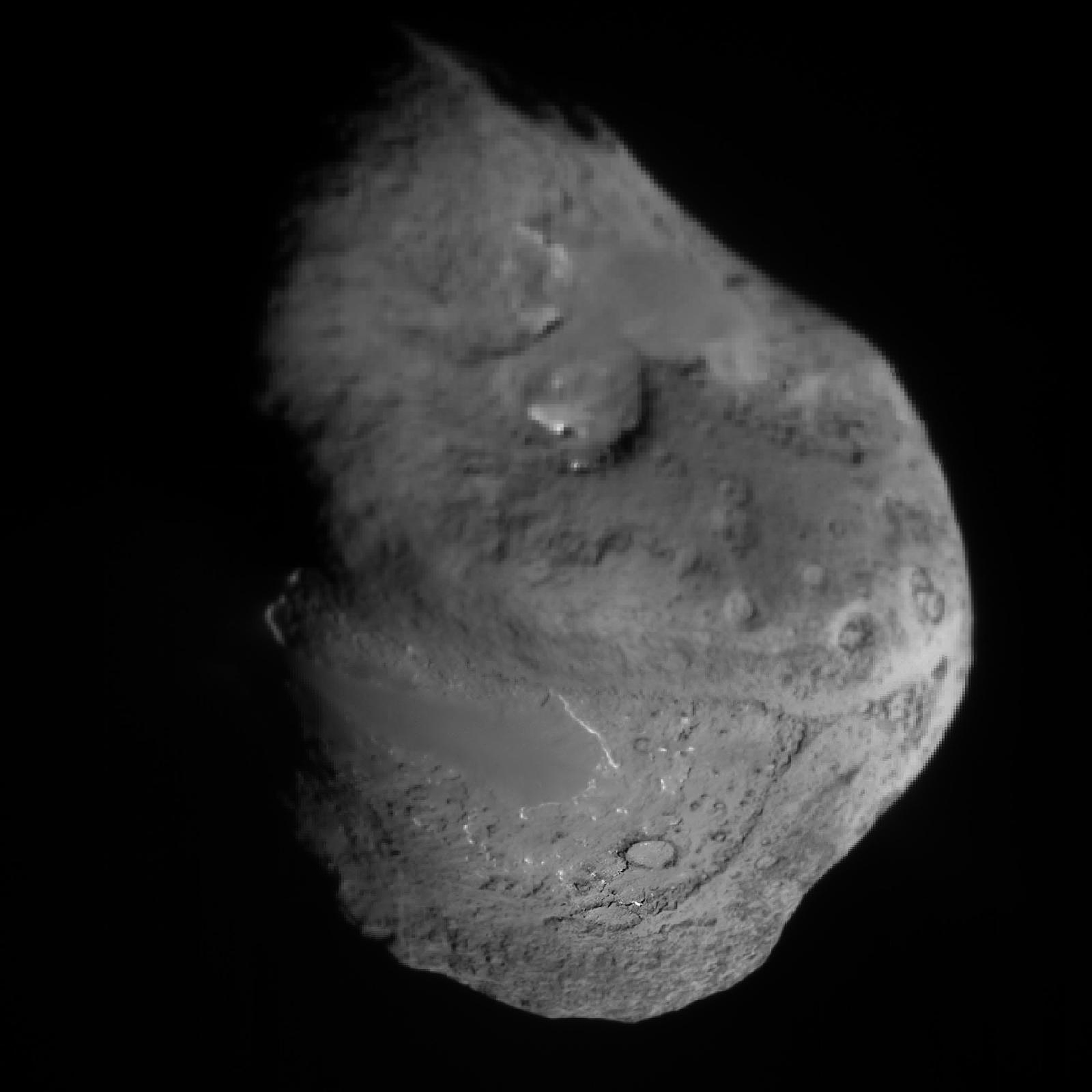
Here is a photograph taken by the impactor, before it became like a bug on a windshield, on July 4, 2005.
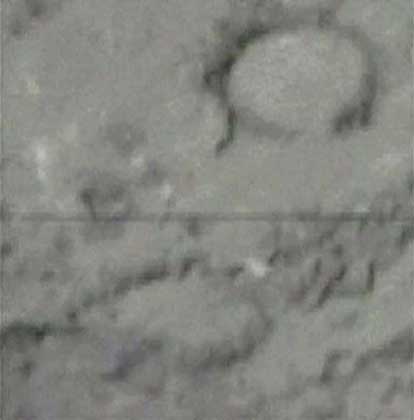
If that’s a bit boring. how about an “oh, SHIT!” GIF?

Or as seen from the main spacecraft:

The impact speed was 10.3 km/second and delivered energy equivalent to 4.7 tons of TNT. We predicted that the crater would be about 100 m across. Only in 2011 did we find out…thanks to a flyby by Stardust, that the crater was roughly 200 m across.
The Impactor bore a CD with the names of 625,000 people encoded on it.
Smack! in Popular Culture
What would happen if one of these hit the Earth?
Well, it would suck. A 1 km wide body hitting us would make every hurricane and earthquake in history put together look like nothing; the entire planet would be affected.
Consider that a long term comet will be moving at pretty close to solar escape velocity. Which when it hit the earth would be about 42 km/sec. Earth would be moving at 30 km/sec. The typical scenario is a right-angle collision, basically Earth getting T-boned by the comet; that’s a collision speed of 51.6 km/sec. Under very unusual (but not impossible) circumstances where the comet’s closest approach is 1 AU and it happens to be headed in exactly the opposite direction to Earth’s motion it could be a head-on collision at 72 km/second, but that’s so unlikely that it’s only worth contemplating if you are so tired of winning that 51.6 km/sec isn’t enough to adequately ruin your day.
An object of, say, 1km in size popping in at that speed would be catastrophic, especially if it hit the ocean. Humanity would probably survive–a death toll of 90+ percent is not 100 percent, but the survivors might find themselves blown back into the stone age…and the lasting effects would make “climate change” look like a mouse fart. Make the asteroid or comet much bigger and…we probably wouldn’t survive.
Tempel, by the way, averages about 6km across. Fortunately it doesn’t cross our orbit and if it did, it wouldn’t be at quite that high a speed.
This doesn’t mean we haven’t contemplated both comet and asteroid strikes. We know an asteroid strike either killed off the dinosaurs, or helped do so. We have those two movies from 1998, Deep Impact and Armageddon. Deep Impact was from a scientific basis a much better movie but it didn’t have Bruce Willis in it.
We also have fiction. Lucifer’s Hammer (1977) was a book by Larry Niven and Jerry Pournelle. They’re both good authors, and they are even better when they work together. It details the discovery of a comet that’s going to come very close to Earth, and follows a number of different people before, during and after the impact. The survivors fight to maintain civilization in the face of torrential rains that lasted for months, hordes of other survivors reduced to barbarism, and the incipient ice age triggered by the impact. Highly recommended.
And then it turned out that the original concept of the novel was that alien invaders had deliberately caused the impact, this time with a moonlet brought from Saturn. For whatever reason their editors had rejected that concept, but Niven and Pournelle had the last laugh; in 1985 they published Footfall, quite possibly the best alien invasion novel ever. And yes, the aliens dropped one in the Indian ocean, killing billions. Also Highly recommended.
Where Our Water Came From
Not every cometary collision is a bad one though. I mentioned at the beginning of this post that Earth lost its water back at the beginning, so the question arises, how is it we have any now? We believe that it was mostly brought in by comets, shortly after the planet cooled. There were a lot more of them back then, and Earth did its part to reduce the numbers.
Nemesis?
In 1984, it was suggested that we might be a binary star. Some very faint red dwarf could be orbiting at about 95,000 AU, outside of the Oort cloud (depending on which estimate for its outer bound is correct), and perturbing comets’ orbits, eventually leading to huge numbers of comets reaching the inner solar system. This would make sense if the red dwarf were in an elliptical orbit, and doing the perturbing only when closest to the Sun. There seemed to be a 26 million year recurring pattern of mass extinctions (not as big as the dinosaur killer or the Great Dying at the end of the Permian, but mass extinctions nonetheless).
With an effect like that, the hypothetical star has been named Nemesis.
Surely we’d know already if we were a binary star? I mean, come on. We don’t see this except on movie screens.
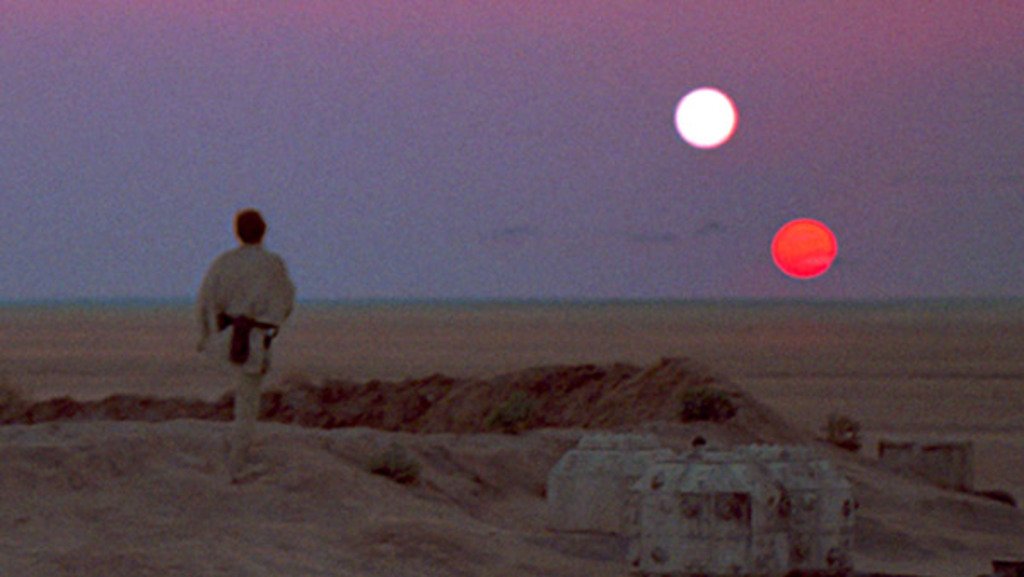
Not necessarily! Most stars are red dwarfs, they’re incredibly faint. None of them are visible to the naked eye at night. None of them, not even the closest one we know of now, Proxima Centauri. So one of these would not be obvious. We’d only be able to tell if we happened to look at the right one and measured its distance and speed. There is a systematic survey being made of red dwarfs, starting with the ones that appear brightest and working their way down. Conceivably, we could get a “hit.” If it’s close enough we could even conceivably send a probe, but it’d be by far the biggest space project ever, and we wouldn’t live to see the pictures.
But as of now, Nemesis is considered very unlikely. Many astronomers think we may once have had a Nemesis but it could have been lost when another star came relatively close sometime in the past.
The End?
That’s comets in a nutshell. Many are denizens of the outermost marches of the Solar System.
As usual I could only scratch the surface of the topic.
This is, I believe, the last of the series on our solar system.
